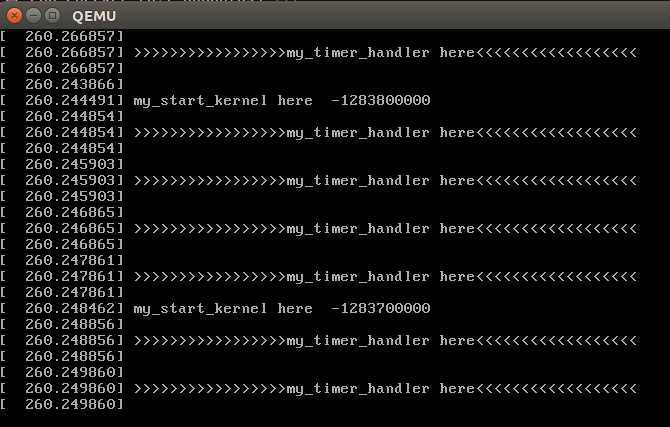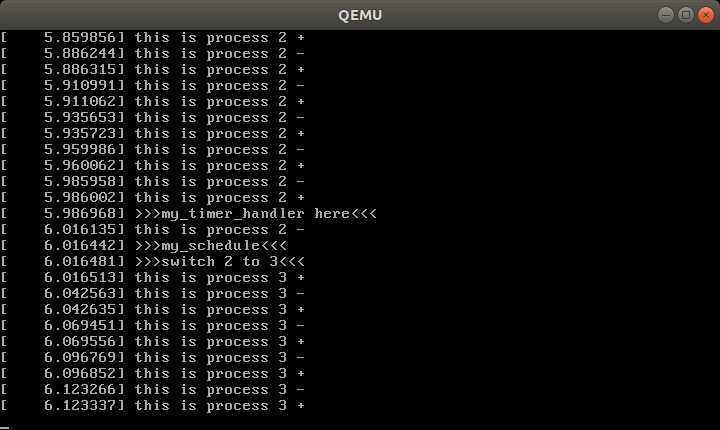实验要求:
实验环境:

实验步骤:
1.按照https://github.com/mengning/mykernel 的说明配置mykernel 2.0,熟悉Linux内核的编译;
wget https://raw.github.com/mengning/mykernel/master/mykernel-2.0_for_linux-5.4.34.patch sudo apt install axel axel -n 20 https://mirrors.edge.kernel.org/pub/linux/kernel/v5.x/linux-5.4.34.tar.xz xz -d linux-5.4.34.tar.xz tar -xvf linux-5.4.34.tar cd linux-5.4.34 patch -p1 < ../mykernel-2.0_for_linux-5.4.34.patch sudo apt install build-essential libncurses-dev bison flex libssl-dev libelf-dev make defconfig # Default configuration is based on ‘x86_64_defconfig‘ make -j$(nproc) # 编译的时间比较久哦 sudo apt install qemu # install QEMU qemu-system-x86_64 -kernel arch/x86/boot/bzImage
结果如下:

2.基于mykernel 2.0编写一个操作系统内核,参照https://github.com/mengning/mykernel提供的范例代码;
在mykernel目录下新建一个mypcb.h 头文件,用来定义进程控制块(Process Control Block);
/* CPU-specific state of this task */ struct Thread { unsigned long ip; unsigned long sp; }; typedef struct PCB{ int pid; volatile long state; /* -1 unrunnable, 0 runnable, >0 stopped */ unsigned long stack[KERNEL_STACK_SIZE]; /* CPU-specific state of this task */ struct Thread thread; unsigned long task_entry; struct PCB *next; }tPCB; void my_schedule(void);
对mymain.c中的my_start_kernel函数进行修改,并实现my_process函数
#include "mypcb.h" tPCB task[MAX_TASK_NUM]; //进程队列 tPCB * my_current_task = NULL; //当前进程 volatile int my_need_sched = 0;//进程调度标志 void my_process(void); void __init my_start_kernel(void) { int pid = 0; int i; /* 初始化0号进程 */ task[pid].pid = pid; task[pid].state = 0;/* 0号进程运行 */ task[pid].task_entry = task[pid].thread.ip = (unsigned long)my_process; task[pid].thread.sp = (unsigned long)&task[pid].stack[KERNEL_STACK_SIZE-1]; task[pid].next = &task[pid]; /*创建更多进程*/ for(i=1;i<MAX_TASK_NUM;i++) { memcpy(&task[i],&task[0],sizeof(tPCB)); task[i].pid = i; task[i].state = 0; task[i].thread.sp = (unsigned long)&task[i].stack[KERNEL_STACK_SIZE-1]; task[i].next = task[i-1].next; task[i-1].next = &task[i]; } /* start process 0 by task[0] */ pid = 0; my_current_task = &task[pid]; asm volatile( "movq %1,%%rsp\n\t" /* 将当前进程的栈顶指针sp值赋值给rsp寄存器中*/ "pushq %1\n\t" /* push rbp */ "pushq %0\n\t" /* push task[pid].thread.ip */ "ret\n\t" /* pop task[pid].thread.ip to rip */ : : "c" (task[pid].thread.ip),"d" (task[pid].thread.sp) /* input c or d mean %ecx/%edx*/ ); } void my_process(void) { int i = 0; while(1) { i++; if(i%10000000 == 0) { printk(KERN_NOTICE "this is process %d -\n",my_current_task->pid); if(my_need_sched == 1) { my_need_sched = 0; my_schedule(); } printk(KERN_NOTICE "this is process %d +\n",my_current_task->pid); } } }
对myinterrupt.c的修改
#include "mypcb.h" extern tPCB task[MAX_TASK_NUM]; extern tPCB * my_current_task; extern volatile int my_need_sched; volatile int time_count = 0; /* * Called by timer interrupt. */ void my_timer_handler(void) //时间片处理函数 { if(time_count%1000 == 0 && my_need_sched != 1) { printk(KERN_NOTICE ">>>my_timer_handler here<<<\n"); my_need_sched = 1; } time_count ++ ; return; } void my_schedule(void) { tPCB * next; tPCB * prev; if(my_current_task == NULL || my_current_task->next == NULL) { return; } printk(KERN_NOTICE ">>>my_schedule<<<\n"); /* schedule */ next = my_current_task->next; prev = my_current_task; if(next->state == 0)/* -1 unrunnable, 0 runnable, >0 stopped */ { my_current_task = next; printk(KERN_NOTICE ">>>switch %d to %d<<<\n",prev->pid,next->pid); /* switch to next process */ asm volatile( "pushq %%rbp\n\t" /* save rbp of prev */ "movq %%rsp,%0\n\t" /* save rsp of prev */ "movq %2,%%rsp\n\t" /* restore rsp of next */ "movq $1f,%1\n\t" /* save rip of prev */ "pushq %3\n\t" "ret\n\t" /* restore rip of next */ "1:\t" /* next process start here */ "popq %%rbp\n\t" : "=m" (prev->thread.sp),"=m" (prev->thread.ip) : "m" (next->thread.sp),"m" (next->thread.ip) ); } return; }
重新编译运行如下

简要分析操作系统内核核心功能及运行工作机制
系统启动之后,mymain.c中的my_start_kernel函数中有一个while循环,会一直执行,在我们修改后的myinterupt.c中,my_timer_handler函数会被内核周期性调用,没运行一千次,就会将全局变量修改为1,my_start_kernel中发现全局变量变为1,就进行进程切换。
原文:https://www.cnblogs.com/dhy970218/p/12877552.html